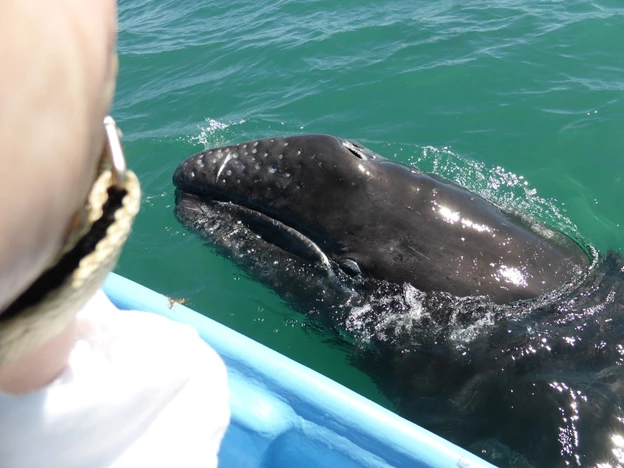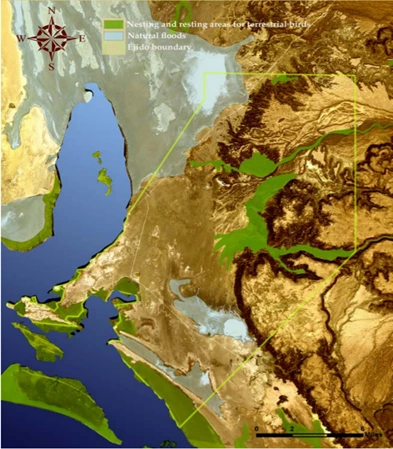A Social Ecology of Whale-Watching Ecotourism in El Vizcaíno
The Baja California Peninsula is one of the most naturally stunning parts of our globe, split from the mainland of Mexico by the San Andreas Fault. Yet for decades, outsiders saw the area as an isolated and unproductive land with minimal economic value. Especially following the decline of the local whaling industry in the early 1900s, regional economic opportunities were limited to fishing, irrigated agriculture and ranching outside of the rise of the saltworks industry in 1954 (more on that later). However, the ‘secret’ of Baja California’s natural beauty was destined to get out. In the latter half of the twentieth century, the arid landscape was reimagined by locals and officials as a tourist’s paradise complete with beaches, surfing and—at least for a few months a year—the opportunity to get up close to Pacific gray whales.

Figure 1: A Pacific gray whale calf approaches a whale-watching boat. Photo by Michael R. Perry licensed under CC BY 2.0.
As an environmental anthropologist in training, understanding the ways in which humans relate to their broader socioecological community is of the utmost importance to me. In ecotourism projects like those that have developed in Baja, these relationships are multifaceted amongst human beings, non-human beings, and the natural landscape. My research focuses on these relationships in the small community of Ejido Luis Echeverría Álvarez (ELEA), located roughly 70 kilometers from Highway Route 1 and the town of San Ignacio on the West coast of Baja California Sur. It is also within the southernmost confines of El Vizcaíno Biosphere Reserve, the largest wildlife refuge in Mexico, and home to exquisite populations of sea turtles, Baja California
pronghorn, and unique flora across a rich landscape.

Figure 2: Close-up map of Laguna San Ignacio and the ELEA ejido. Map by WiLDCOAST.
And remember those Pacific gray whales I mentioned earlier? Well, it just so happens that ELEA is on the coast of one of the last breeding grounds unmarred by human activity at the end of their migration from the Arctic: Laguna San Ignacio. Unfortunately, at the turn of the 21st century, industry was mounting a threat to the local ecosystem. Within a few hours drive to the North, a joint venture of the Mexican government and Mitsubishi known as Exportadora de Sal, S.A. (ESSA) already operates the world’s largest sea salt facility. This facility also lies on the coast of a whale breeding lagoon known as Laguna Ojo Liebre, and ESSA saw Laguna San Ignacio as a logical location to expand their operation.
Environmental NGOs, celebrities, and conservationists mobilized over fears that the new facility and the massive ships that would come with it would disrupt Laguna San Ignacio like the original ESSA plant had done at Ojo Liebre. The pressure eventually convinced former President Ernesto Zedillo to cancel the plan in 2000. Due to concessions by the Mexican government to ESSA just a year later, and other ecological threats including exploratory fossil fuel drilling in the lagoon, groups like Pronatura and WiLDCOAST went the extra step to place conservation easements and non-development agreements into effect with local ejidos in exchange for community funding—the first of which took effect in 2005 across 120,000 acres in ELEA. However, regulations on whale conservation and growing interest in the lagoon threatened to restrict access to the local fishery that many locals had historically relied upon.

Figure 3: A vehicle carries sea salt at the ESSA facility in Guerrero Negro. Image by WHALE MAGIC Tours licensed under Creative Commons.
What resulted was a complex web of relations between fishermen, ecotourism workers, government actors, and the whales themselves. But this relational web doesn’t stop there. It extends to the larger system of ecological relationships the whales inhabit across the thousands of miles they travel to give birth, including the productivity of the benthic ecosystem they rely on in the Arctic for food.
As one of many tourists who had traveled to enjoy the Baja shores (including a visit to Laguna Ojo Liebre in late 2016), I grew interested in how ecotourism, industrial and conservation efforts had impacted local communities. How had my presence contributed to the complex issues facing communities in El Vizcaíno? And when I think of communities, I don’t just imagine families, neighborhoods, and local restaurants filled with patrons. Communities extend to non-human beings too. To understand environmental issues in the social sciences, it is critical to center the roles and agency of plants, animals, and microbes that inhabit space alongside us humans. Other living things aren’t just there to provide value for people, and as we work to address the environmental realities of the contemporary age, we can’t forget that.
Working to supplement the excellent ecological research produced by the Laguna San Ignacio Ecosystem Science Program, my research seeks to understand the socioecological and economic impact of this conservation development deal on the multi-species community of ELEA. During my time in ELEA, I seek to understand the relationships, connections, and outcomes of this project by employing multi-species ethnography and participant observation. Multi-species ethnography works to understand the ‘contact zones’ where the existences of humans and non-human beings collide. To accomplish this, it is critical to frame animals, plants and microbes as central actors in my research. This project centers grey whales, benthic organisms, fish populations, human community members, and the relationship of these beings to the entire biosphere reserve. With insight from these diverse groups, I hope to provide further nuance to our understanding of the dynamic realities of ecotourism in El Vizcaíno—and whether the industry provides the economic and ecological benefits it has promised.

